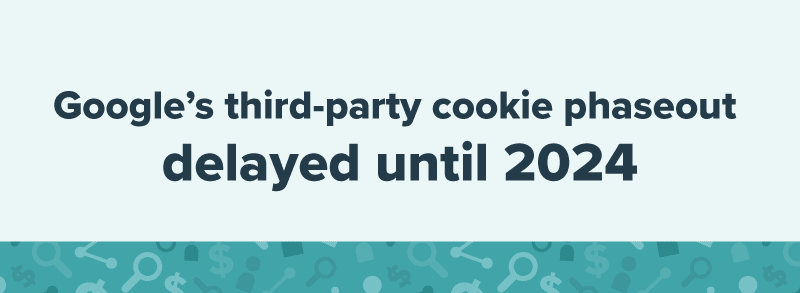Google Moves Goal Posts Again, Delays Cookie Phase-Out Until at Least 2024


“Reports of my death are greatly exaggerated.” – Third-Party Cookies / Mark Twain
Google‘s plan to phase out support for third-party cookies in 2022-23 will now be delayed even further, until at least 2024, the company announced in a blog post on July 27th.
Back in 2020, the company announced that the cookiepocalypse — the demise of tracking cookies in its popular Chrome browser — was coming “within two years.”
By mid-2021, that timeline was extended to 2023. Now, the global tech giant says it will hold off until 2024 to replace what has been its primary means of targeted advertising.
“The most consistent feedback we’ve received is the need for more time to evaluate and test the new Privacy Sandbox technologies before deprecating third-party cookies in Chrome,” Anthony Chavez, Google’s Vice President of Privacy Sandbox, said Wednesday.
“As developers adopt these APIs, we now intend to begin phasing out third-party cookies in Chrome in the second half of 2024.”

Cookies are small pieces of code that websites deliver to a visitor’s browser. They stick around as the user visits other websites, tracking data and fueling much of the digital advertising ecosystem as we know it. But times are changing.
While cookies remain alive and well on Chrome, Google has long recognized that the needs of users, publishers and advertisers have evolved and require new strategies.
This week’s delay, like last year’s, was necessary because those new strategies are extraordinarily complex, and we are all in uncharted territory. It gives the digital advertising industry more time to develop multifaceted solutions for a more privacy-conscious web.
The second delay also comes at a turbulent time for Google and other tech giants, who have been hit hard by privacy changes from Apple’s iOS — which has already reduced targeting capabilities — and scrutinized by lawmakers in the U.S. and Europe over antitrust concerns.
Looking ahead, according to Chavez, Google is expanding the testing window for Privacy Sandbox APIs. Since its launch in 2019, the Privacy Sandbox has set out to find effective alternatives to cookies while mitigating the impact on publishers and advertisers.
Three years later, the current timeline looks like this:
Basically, this takes us to late 2024, or perhaps early 2025, assuming all goes according to plan.
Four words: More time, more money.
Obviously, that’s an oversimplification, but there’s some truth to it. More time to get this transition right is a good thing — both in the sense that we have two additional years of stability and targeting via this known commodity, and two additional years to pave a path forward.
While working with Google and other major industry players to help implement ideas like the Privacy Sandbox, Mediavine has invested heavily in its own solution, too.
Perhaps you’ve heard of it.
You can’t talk about the end of cookies without talking about first-party data, the information that the publisher (your website) provides to advertisers about a reader.
It’s called first-party data because the website a reader is on will provide the data directly to the advertiser, rather than via the reader’s browser history.
Third-party data is called that quite literally because we’re all relying on a third entity — the reader’s browser — to provide the data we need to complete the ad transaction between the advertiser and the website owner that makes money from ads.
Grow is Mediavine’s plan for this transition, and the best part is this: Whether cookies become a relic of the past in 2024 or 2034, it will help you earn more today.

As an audience engagement suite that encourages readers to log in and consent to personalized ads, Grow helps you build first-party data for the future, years ahead of the curve.
Consenting, or authenticated, users will be even more valuable than cookie-driven traffic — not just in 2024 but immediately. We’ve already seen this in action.
With iOS, as we mentioned, cookies are already extinct. Eventually, Chrome will follow. And regardless of when that happens, Grow is an instant value-add for reasons beyond data.
With significant improvements to user experience and ad performance, you can increase your user base, session duration, pages per session and more with Grow — now.
With features like Recommended Content, Search, Subscribe, and many more in the pipeline, thousands of publishers are already providing audiences with better experiences, reaping the financial benefits today and preparing for the future simultaneously.
Perhaps the biggest challenge of first-party data is that it requires scale to be successful. We now have even more time to authenticate enough users to move the needle – and that’s on top of our huge head start, plus the optimizations of traffic and revenue that are immediate.
Stay up to date with the latest from Mediavine
Welcome to the much-anticipated release of the fifth-annual edition of “The Best eCPM Days of the Year” calendar. Each year, we analyze historical trends to provide publishers with a graphical …
In today’s digital landscape, advertisers are becoming increasingly selective about where they place their ads. With the growing importance of brand safety, audience engagement and ROI, the quality of a …
 Eric Hochberger
Eric Hochberger
Since the advent of Trellis, Mediavine’s goal was to provide a WordPress framework to meet the needs and pain points of independent publishers. We’ve had the pleasure of working with …